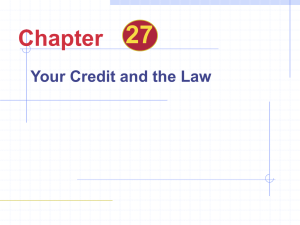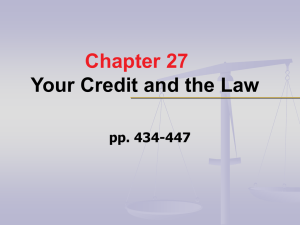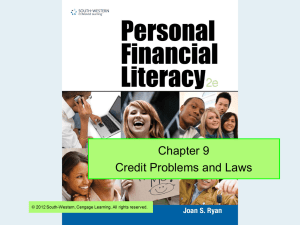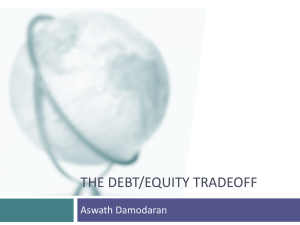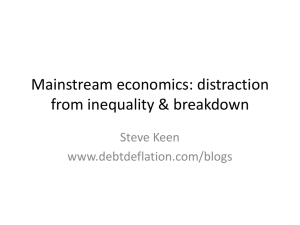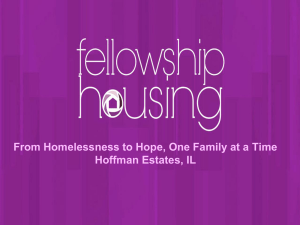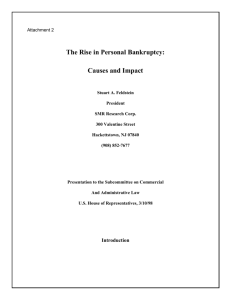Advocacy and Empowerment Workshop
advertisement
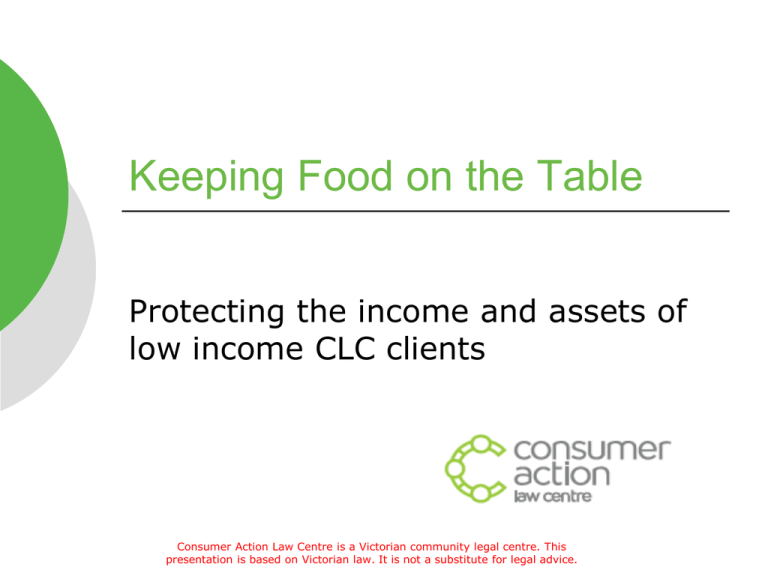
Keeping Food on the Table Protecting the income and assets of low income CLC clients Consumer Action Law Centre is a Victorian community legal centre. This presentation is based on Victorian law. It is not a substitute for legal advice. Consumer Action Law Centre Not for profit, campaign focused consumer advocacy, litigation and policy organisation based in Melbourne Free legal advice and representation to vulnerable and disadvantaged consumers across Victoria Legal assistance and professional training to community workers who advocate on behalf of consumers www.consumeraction.org.au Credit and Debt How do you assess whether a person needs to pay a debt? Disputing liability for the debt (later) Options where the debt is owed Must they pay? Look at client through the ‘lens’ of their financial position Just because the creditor claims that there is a debt (or a contract) does not mean the debt is owed or that the person must pay Scenario #1 A client with no income (other than Centrelink) or assets (other than normal household items) Option 1 Cease repayments Centrelink income is protected even if Judgment is obtained No assets other than ordinary household items means that there is nothing to seize Option 1 Cease repayments cont… The debt remains and will increase. Does this matter to your client? Is there a likelihood of future income or assets? When? Client will lose goods that are secured by the debt (eg a car) or services (eg utilities) Adverse credit report Risk of harassment Option 1 Cease repayments cont . . . New debt collection laws (Vic) prohibit contacting a person after a person advises in writing that no further communication should be made about that debt unless the contact is by way of an action issued through a court or VCAT or by notice of intention to issue. Option 1 Cease repayments cont . . . Stopping harassment: ‘Stop contact’ letter (see pro forma letter and CALC FS12D) Follow up in EDR or VCAT if contact persists (see VCAT application) Option 2 Bankruptcy Advantages: Provides a clean slate No adverse changes to person’s current financial position Severs relationship with debt collector Note: Bankruptcy remains on credit report for 7 years (but bad debts are on there for 5) Some restrictions on employment Some debts are not wiped (child support, court fines, infringements, debts incurred by fraud) Option 3 Negotiation Bulk debt negotiation for waiver Seek waiver of individual debt (or refer to financial counsellor) Negotiate settlement and/or use EDR for hardship variation if client needs to pay (FOS, COSL, TIO, EWOV) Negotiation cont . . . A client with Centrelink income who needs to pay is often in a good position to negotiate with a creditor Scenario #2 A person on low income, with some or no assets When does low income mean that you have to pay? Judgment Debt Recovery instalment and attachment of earnings orders Warrant to seize property OR Bankruptcy? Option 1 Enforcement orders Once Judgment is obtained the creditor or the debtor may apply to the court for an instalment order – no minimum income threshold or the creditor may seek to enforce the debt through an order for the attachment of the debtor’s earnings – again, no minimum income threshold; maximum of 20% after tax income Option 1 Enforcement orders cont . . . or the creditor may seek a warrant to seize property not protected by Bankruptcy Act and Regulations. Option 2 Bankruptcy Bankruptcy will protect a person with a low income from having to pay any of the debt back A single (bankrupt) person with no dependants can earn $47 693.00 (indexed) after tax with no obligation to pay anything to his/her creditors. Again no adverse changes to client’s current financial position Option 2 Bankruptcy cont . . . If your client is struggling to buy food or other essentials, why should they pay? The law offers protection to our vulnerable clients for good reason Option 3 Negotiation Income under bankruptcy threshold provides a negotiation tool for clients who need to pay Hardship variations Compulsory EDR for financial institutions (hardship, over commitment etc) available even after proceedings issued Option 3 Negotiation cont. . . Consider ‘Stop contact’ letter. Amend to indicate client’s income is below bankruptcy threshold if necessary. But increased risk of court action. Scenario #3 A person on low income & significant assets Seek legal advice from Consumer Action Law Centre Risk management Clients should be made aware of potential defences or remedies they have against demands from creditors Whether or not you think there is a legal defence or remedy, seek legal advice from CALC as there may be a significant risk that your client will unnecessarily lose their home or another asset of value to them. Consider the many legal defences Misleading and/or deceptive conduct Unconscionable conduct (common law and ACL) Unfair contract terms (gym, telecommunications) Mental disability and intoxication Limitation of actions Minority Legal defences cont . . . Consumer guarantees breaches (unfit for purpose, unacceptable in appearance, defective, unsafe, not durable) Unsolicited consumer agreements (cooling off rights:10 days, 3 months, 6 months) Legal Defences cont . . . Unfair practices Accepting payment without intention to supply Harassment and coercion Credit Code defences/remedies Linked credit (bank, educational college) Over commitment/ irresponsible lending Hardship (new threshold of $500,000) Leases in disguise False business purpose declarations Credit Code defences cont . . . No caveats (practice of some brokers) No blackmail securities EDR with FOS or COSL, even when proceedings issued against consumer Payday loans: responsible lending? Prohibited mortgages (all property) Key messages MoneyHelp: telephone financial counselling service 1800 007 007 Strong law against harassment: use it or lose it (VCAT or EDR) EDR with FSPs (financial service providers) available after FSP has issued legal proceedings CALC offers legal advice and casework support Any questions? Consumer Action Law Centre Level 7, 459 Little Collins Street Melbourne VIC 3000 Advice line: 9602 3326 (worker only) or 9629 6300 Rural access: 1300 881 020 Email: advice@consumeraction.org.au
